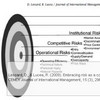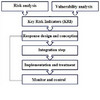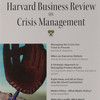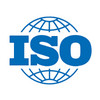 We live in a world that is full of risk, risks that we to a large degree have created ourselves, and where naturally occuring risk hardly exists anymore. That is a risk society. With that at the back of his mind, Jan Hovden of the Norwegian University of Science and Technology, NTNU, developed a framework that incorporates risk and vulnerability, that includes safety hazards and security threats and that adds both a micro and a macro perspective. It is a framework that fully accounts for most if not all of the risks that we have to face to a larger or lesser extent. Why is this framework not used more often?
We live in a world that is full of risk, risks that we to a large degree have created ourselves, and where naturally occuring risk hardly exists anymore. That is a risk society. With that at the back of his mind, Jan Hovden of the Norwegian University of Science and Technology, NTNU, developed a framework that incorporates risk and vulnerability, that includes safety hazards and security threats and that adds both a micro and a macro perspective. It is a framework that fully accounts for most if not all of the risks that we have to face to a larger or lesser extent. Why is this framework not used more often?
Risk society
According to Wikipedia, “Risk society” is a term that emerged during the 1990s to describe the manner in which modern society organises in response to risk. The term is in particular realted to Anhony Giddens’ The Consequences of Modernity and Ulrich Beck’s Risk Society: Towards a New Modernity
. According to sociologist Anthony Giddens, a risk society is “a society increasingly preoccupied with the future (and also with safety), which generates the notion of risk,” whilst the German sociologist Ulrich Beck defines it as a systematic way of dealing with hazards and insecurities induced and introduced by modernisation itself.
Risk and vulnerability in the risk society
In a conference paper presented at the 15th Nordic Research Conference on Safety (NoFS XV) in 2003, and available for download below, Hovden picks up and elaborates the notions of risk society, and he says that
New risks are continuously revealed and linked to changes in technology, biology, social tensions and politics. A main difference from traditional risks is that they are independent of the place where you live or work. … The modern risk awareness is not about our own experiences or the current statistical risk picture of deaths and injuries, but about an uncertain future. Fear and anxiety of these threats which we are uncertain or ignorant about, are a great challenge for risk management even though the probabilities for such events may be microscopic. The frightening is that we dont know, and are out of control. We feel like victims.
In the same paper he presents the figure below which describes a holistic macro-micro perspective on risk management in the risk society, where hazards/threats and events create a combined backdrop of risk and vulnerability:
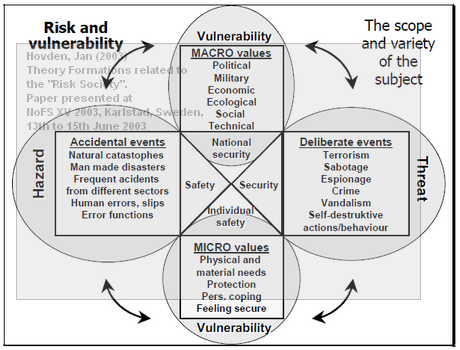 Risk is here related to a concrete event, either accidental (hazards) or deliberate (threats). Vulnerability is related to the our ability to cope with it, either on a personal (micro) level or an a societal (macro) level). The former refers to individual safety, the latter refers to mational security. This figure was also presented in an article Hovden published in 2004.
Risk is here related to a concrete event, either accidental (hazards) or deliberate (threats). Vulnerability is related to the our ability to cope with it, either on a personal (micro) level or an a societal (macro) level). The former refers to individual safety, the latter refers to mational security. This figure was also presented in an article Hovden published in 2004.
Critique
In my opinion this is a complete framework that fully captures the immediate (personal) and more distant (societal) effects of accidental and malicious events. Applied to a supply chain, the “personal” sphere could be replaced by a “business” sphere, while leaving the national sphere as is. This would be in line with what Peck (2006) wrote in Reconciling supply chain vulnerability, risk and supply chain management, where supply chains link industries and economies and serve a purpose that extends far beyond the functional concerns and stated aims of SCM.
References
Hovden, J (2003) Theory Formations related to the “Risk Society”. Paper presented at NoFS XV 2003, Karlstad, Sweden, 13th to 15th June 2003
Hovden, J. (2004). Public policy and administration in a vulnerable society: regulatory reforms initiated by a Norwegian commission Journal of Risk Research, 7 (6), 629-641 DOI: 10.1080/1366987042000192228
Author link
- ntnu.no: Jan Hovden
Related
- husdal.com: Can it really be that dangerous

